#Montgomery Pittman
Explore tagged Tumblr posts
Text





















From the Golden Age of Television
Series Premiere
West Point - The Mystery of Cadet Layton - CBS - October 5, 1956
Drama
Running Time: 30 minutes
Written by Jerome Lawrence and Robert E. Lee
Produced by Leon Benson and Ivan Tors
Directed by Leon Benson
Stars:
Donald May as Cadet Lt. Charles C Thompson / Host
Martin Milner as Cadet Jonathan B. Layton
Donald Eitner as Cadet Townsend
Carolyn Craig as Judy Miller
Ray Montgomery as Major McKyver
Frank Fenton as Brigadier General Rogers
Tom Pittman as Company Commander
Richard Tyler as Cadet Rick Williams
Michael Miller as Cadet Wally Sterling
George Leigh as Superintendent
Butler Hixon as Hotel Manager
Sumner Williams as Cadet
#The Mystery of Cadet Layton#West Point#TV#Drama#CBS#1950's#1956#Martin Milner#David Eitner#Carolyn Craig#Ray Montgomery
2 notes
·
View notes
Text

Willys Wednesday; a pair of '33's - Ohio George Montgomery (near) vs K.S. Pittman
30 notes
·
View notes
Text
mobile friendly muse page
all fcs on this page are also available for new charas * means not yet added to full muse page
males:
andrew rogers / sebastian stan fc / heterosexual / 31-36 yo / mob boss august cowan / pablo schreiber fc / heterosexual / 41-48 yo christian deleon / lewis tan fc / heterosexual / 33-42 yo / handyman darren pittman / dacre montgomery fc / heterosexual / 28-34 yo grant carpenter / andrew lincoln fc / heterosexual / 49-53 yo / rich divorcee jason griffin / henry cavill fc / heterosexual / 35-39 yo jude vega / jon bernthal fc / heterosexual / 42-51 yo nicholas vaughn / ben barnes fc / heterosexual / 34-39 yo samuel hart / frank grillo fc / heterosexual / 48-54 yo vincent jimenez / pedro pascal fc / heterosexual / 44-52 yo
females:
addison greer / anne hathaway fc / pansexual / 36-42 yo aida warren / alycia debnam carey fc / pansexual (prefers ladies) / 26-32 yo arden blackwell / jessie mei li fc / pansexual / 29-34 yo celine houston / alexis ren or lili reinhart fc / pansexual / 25-31 yo channing graves / elizabeth olsen fc / pansexual / 28-34 yo cherry bennett / natalia dyer fc / pansexual / 22-28 yo frankie benton / jessica chastain fc / pansexual / 38-46 yo hanna burgess / madelyn cline fc / pansexual / 23-29 yo heather galvan / alexa demie fc / pansexual / 28-34 yo ivanna marks / camila mendes fc / pansexual / 26-31 yo maria almasi / may calamawy fc / pansexual / 34-40 yo marie mcdaniels / famke janssen fc / pansexual / 41-47 yo mayson hayes / morena baccarin fc / pansexual / 38-42 yo rowan dunn / grace van dien fc / pansexual / 25-29 yo stella monroe / dianna agron fc / pansexual / 26-37 yo
faces i'm willing to play
lili reinhart madelaine petsch sydney sweeney dakota johnson ella purnell sophie nelisse camila morrone savannah smith liz gillies alexa demie natasha lyonne oscar isaac jensen ackles glen powell charlie cox andrew garfield john boyega + more, just ask!
2 notes
·
View notes
Text

William Sidney Pittman (April 21, 1875 - March 14, 1958) was a noted architect and advocate for civil rights. Working in both DC and Dallas, he made significant contributions to each city’s physical and cultural landscape while paving the way for more African Americans to become architects.
He was born in Montgomery. He worked for his uncle, who was a carpenter. He graduated from Tuskegee University. He studied Mechanical and Architectural Drawing. With the support of Booker T. Washington, continued his education at the Drexel Institute. He graduated with a diploma in Architectural Drawing.
He returned to the Tuskegee Institute and worked as the head of the department of architectural drawing. He taught as an assistant professor in the Division of Architectural and Mechanical Drawing.
He started as a draftsman for the architect John Anderson Lankford but opened his office. His office was the first office opened in the US by an African American architect. The first building he was commissioned to design was the Trinity AME Zion church. He was awarded the contract to design the Negro Building at the Jamestown Exposition which marked the upcoming 300th anniversary of the first permanent European settlement on the North American mainland.
He married Portia Marshall Washington (1907) the daughter of Booker T. Washington. The couple had three children. He designed many prominent buildings, including the Garfield Elementary Public School and the 12th Street YMCA Building.
They moved his family to Dallas where he kept working as an architect and continued to design many notable buildings including the Pythian Temple. He began to have trouble securing work partly due to creative frustrations and partly due to the rigid pattern of racial segregation. His wife returned to Tuskegee. He stayed in Texas but was unable to keep his architecture business going. He worked as a carpenter and published the weekly paper The Brotherhood Eyes. #africanhistory365 #africanexcellence
0 notes
Text
Prosecutor pursues public employees, and 9 more South Jersey stories you may have missed
Fred Gilbert: · LaQuay DuBose: · Marc Snead: · Corie Pittman: · Roger Tees: · Fariyd Holmes: · Michelle Calderon: · Laurie Montgomery: …
View On WordPress
0 notes
Text
2023 - Week 2
BUF - Josh Allen leads the league with a 76.9% completion percentage
NE - Ty Montgomery has a 43 yard kickoff return, the longest in the league this season
MIA - Tua has averaged 9.5 yards per pass attempt, the most in the league
NYJ - Breece Hall averages 9.71 yards per carry, the highest in the league
BAL - Geno Stone leads the AFC with 36 interception return yards
PIT - TJ Watt is tied for the league lead with 4 sacks
CLE - Nick Chubb leads the AFC with 170 rushing yards
CIN - Charlie Jones leads the league with 105 punt return yards, highlighted by an 81 yard TD on Sunday
TEN - Derrick Henry is second among AFC RBs with 87 yards after catch
JAX - Josh Allen is second in the AFC with 3 sacks
IND - Michael Pittman has 16 receptions, second most in the AFC
HOU - CJ Stroud has thrown 91 passes without an interception, most in the league
KC - Tommy Townsend leads all AFC punters with a 46.6 yard net punting average
LV - Davante Adams has 9 receiving first downs, second most in the AFC
LAC - Cameron Dicker has scored 20 points through two games, second most among AFC kickers
DEN - Russell Wilson has a 108.5 QB rating, best in the AFC
DAL - CeeDee Lamb has 103 yards after catch, second in league
WAS - Brian Robinson has run for 13 first downs, most in the league
PHL - Jake Elliott has hit more 50+ yard FGs than anyone else in the league with 3
NYG - The Giants overcame a 20-0 deficit at the half, their largest comeback in the Super Bowl era
GB - Jordan Love has 6 TD passes, tied for the league lead
CHI - TJ Edwards has 26 tackles, second in the NFC
DET - Sam LaPorta leads all rookie TEs with 10 receptions
MIN - Danielle Hunter is tied for the league lead with 4 sacks
NO - Rashid Shaheed leads the NFL with 157 kickoff return yards
TB - Mike Evans averages 19.75 yards per reception, tops in the NFC
ATL - Bijan Robinson leads all running backs with 95 yards after catch
CAR - Chuba Hubbard leads the NFC with 6.91 yards per carry
SEA - DeeJay Dallas has a 34 yard kickoff return, the longest in the NFC this year
LAR - Puka Nacua leads the league with 25 receptions
ARI - Zach Ertz has 12 receptions, second most among TEs
SF - Christian McCaffrey leads the league with 268 yards rushing
0 notes
Text
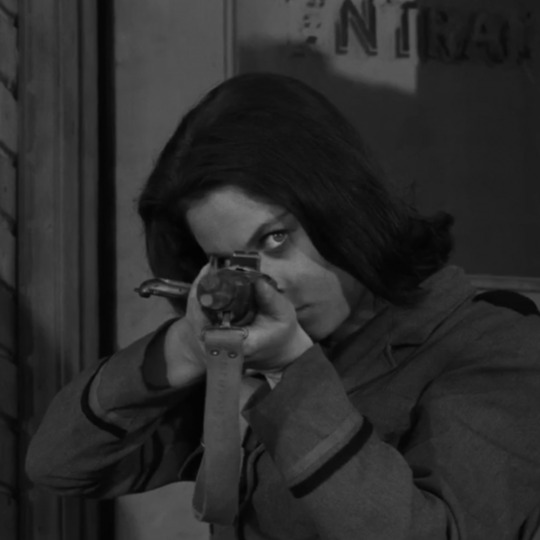
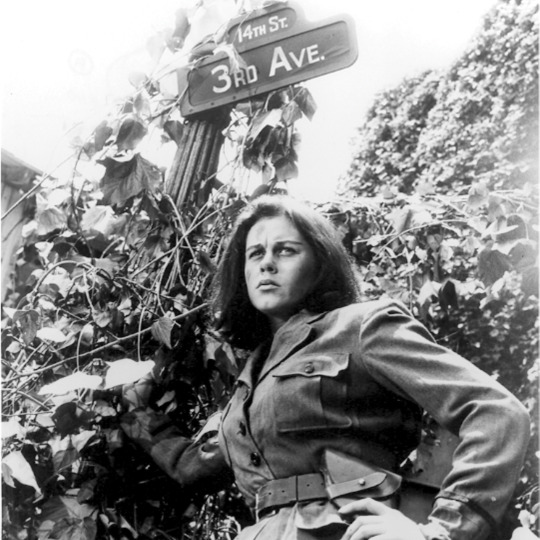
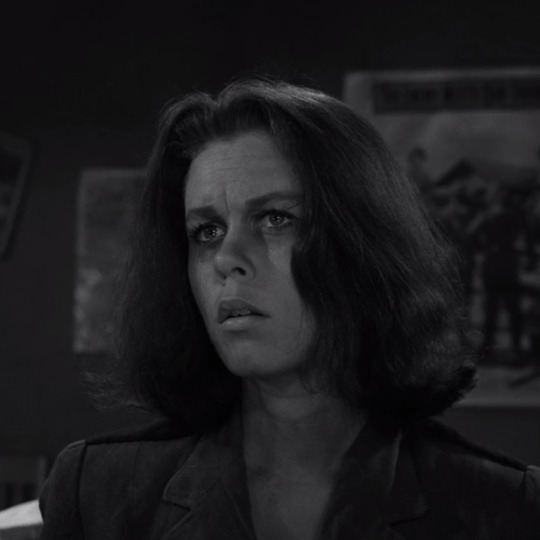
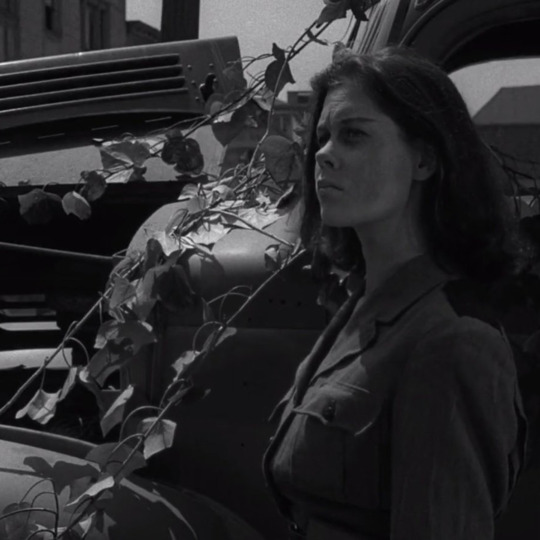
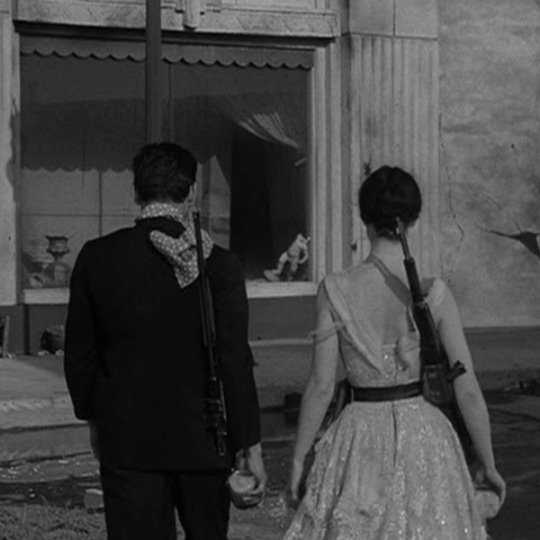
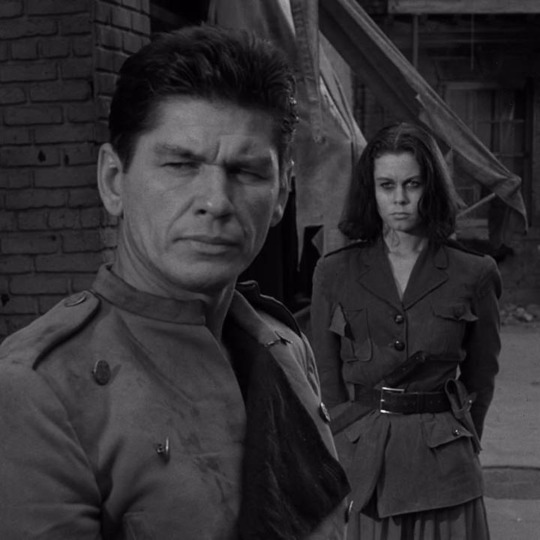
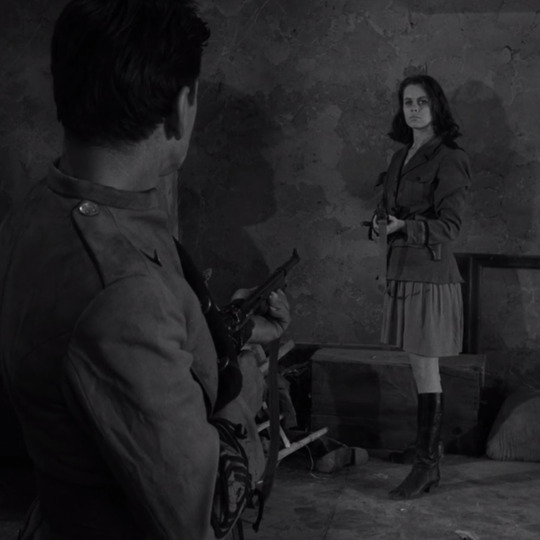
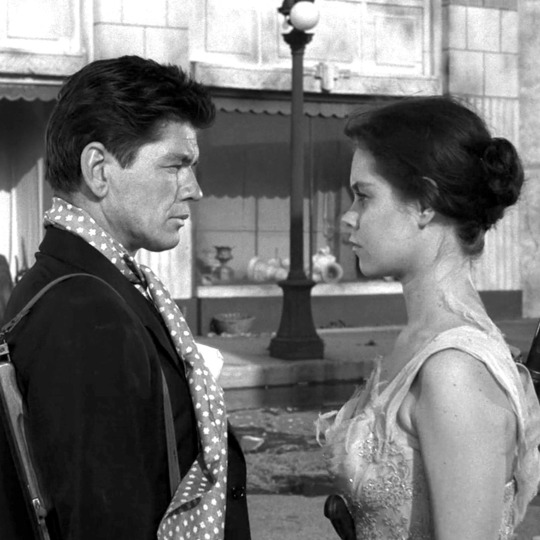
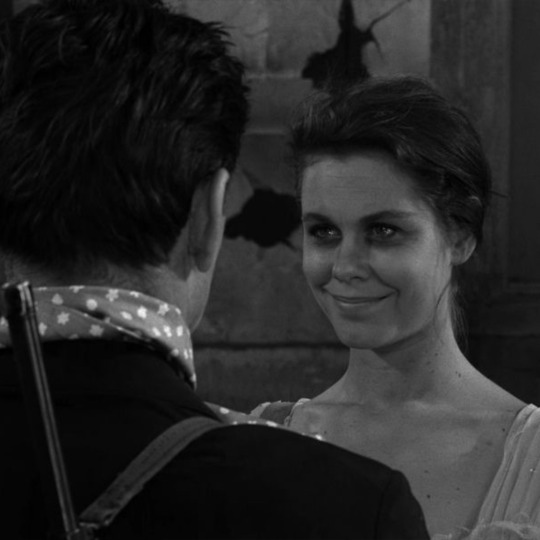
The Twilight Zone | Two
September 15, 1961
S3E1
Icons
#icons#60s style#60s icons#the twilight zone#the twilight zone icons#elizabeth montgomery#charles bronson#post war#1961#tv series#rod serling#vintage icons#soldier#soldier icons#1960#1960's#1960s aesthetic#1960s icons#montgomery pittman
60 notes
·
View notes
Photo










3.01 Two
Director: Montgomery Pittman
Director of Photography: George T. Clemens
“This is a jungle, a monument built by nature honoring disuse, commemorating a few years of nature being left to its own devices. But it's another kind of jungle, the kind that comes in the aftermath of man's battles against himself.”
#Twilight Zone#the twilight zone#season 3#two#montgomery pittman#george t clemens#Rod Serling#elizabeth montgomery#charles bronson#1960s#sixties#television#Classic TV#classic television#cinematography#close up#close-up#scifi#speculative fiction
106 notes
·
View notes
Text
You’re traveling through another dimension…
The place is New Jersey, the time is 2001, and the journey into the shadows that you’re about to read is my journey. My journey in committing myself to see every episode of The Twilight Zone.

I grew up watching Twilight Zone reruns on TV; loving the style, imagination, and colorful characters. In or around 2001, as a high-school freshman, I saved up to buy The Twilight Zone Companion by Marc Scott Zicree. It shocked me to learn how many episodes of the show I hadn’t seen after years of faithfully watching reruns and the bi-annual marathons.

Yes, this is that same copy of The Twilight Zone Companion.
Setting a goal for myself to see every episode, checking them off in the book as I went along, was a daunting task back then. Not only were there no streaming services, but also no complete home-video release. (For the longest time CBS Home Video only released collections of episodes in no discernible order on VHS and DVD.) On top of that, a few of the episodes were not in syndication. Praise be to Serling, my parents owned one of the compilation tapes that included one of these episodes (The Encounter). Of course, I then understood why it wasn’t in syndication… It has since returned to the airwaves for some reason.
In the end, it took me a little over a year to see all of them with the help of timed recording on my VCR.
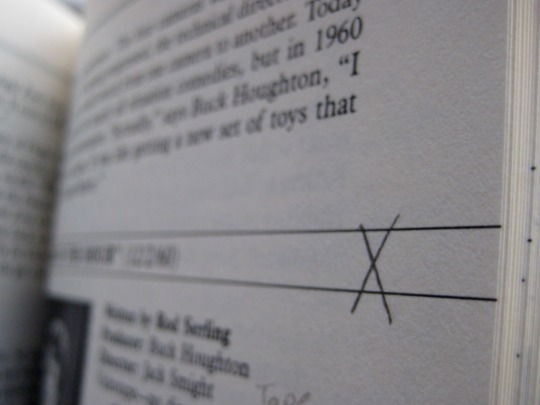
I wasn’t lying about checking off the episodes...
It’s great that The Twilight Zone is now available on multiple streaming services in addition to The Scifi Channel still playing reruns. Now none of you need to have my single-minded dedication to seemingly pointless tasks to discover television shows that were cancelled forty years before you were born.
Over the next two days, in honor of the marathon, I’ll make a series of posts to help all of you make the most of your first journey into imagination of 2018.

Below the jump, you’ll find a little bit about each of my favorite episodes. That’s the signpost up ahead--
--your next stop, The Twilight Zone!
The Invaders
Season 2, Episode 15
Director: Douglas Heyes | Writer: Richard Matheson
A woman living in an isolated cabin spends a terrifying night with tiny spacemen.

Agnes Moorehead is undoubtedly one of the best and most under-appreciated actors of the last century. The Invaders is a great episode from a technical and stylistic standpoint, but Moorehead’s performance still stands out. What a wonderful stroke of genius it was to take a woman so known for her radio work, for her inimitable voice, and cast her in a role with no dialogue. It’s a testament to how well this episode is made that the titular invaders are honest-to-goodness hand puppets but it’s one of the series’ most tense and terrifying entries.
A Stop at Willoughby
Season 1, Episode 30
Director: Robert Parrish | Writer: Rod Serling
A harrowed Madison Avenue ad man, dissatisfied with his life, begins to dream about another, quieter life in a town called Willoughby.

Nostalgia is a common theme throughout the entirety of the series and this is examination of sehnsucht the best execution of the theme. Gart Williams (James Daly) isn’t wistful about his own past (as with the simpler, but also great Walking Distance). Instead he yearns for some nebulous summer in the late 19th century, some nebulous place in America, unknown to him but relaxed enough that he’d have all the time in the world to “live his life full measure.” James Daly portrays Gart as someone who is too tired to continue functioning professionally or personally. His turn to nostalgia is driven by depression and the exhaustion that depression always seems to have at the ready in its handbag.
Will the Real Martian Please Stand Up?
Season 2, Episode 28
Director: Montgomery Pittman | Writer: Rod Serling
When a UFO crashes into the woods on a snowy night, two state troopers track footprints to a roadside diner filled with bus passengers stuck by a bridge gone out. Will they be able to figure out who doesn’t belong?

Serling takes a classic mystery premise and adds a science-fictional spin with Will the Real Martian Please Stand Up? It’s a lively episode with well-limned character work. Serling loves karmic retribution, especially when it takes the form of a twist on top of a twist. This episode illustrates the concept in spades, though I won’t elaborate further in case you haven’t seen this one yet!
Where is Everybody?
Season 1, Episode 1
Director: Robert Stevens | Writer: Rod Serling
A man arrives at a small town with no idea how he got there or who he is. Unfortunately, there’s not a single soul in town to clear things up for him.
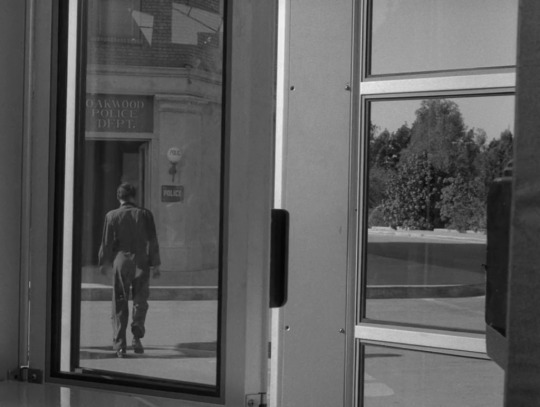
The origins of The Twilight Zone lie in a TV drama Rod Serling wrote called The Time Element (which is on the complete series home video release btw). That story certainly contains the necessary ingredients we’ve now come to associate with the show, but it’s with the pilot Where is Everybody? that Serling hammers out exactly how he plans to approach short speculative stories: Human dramas that often deal with the interior life of a person when they’re faced with extraordinary circumstance. Earl Holliman’s acting is often rightfully lauded as well as Serling’s writing. The camera work by Joseph La Shelle is incredibly artful for TV photography of the time, using camera angles and movement to reflect the feelings of the main character or to emphasize the feeling of being watched by an unseen observer.
Nothing in the Dark
Season 3, Episode 16
Director: Lamont Johnson | Writer: George Clayton Johnson
An elderly, fearful woman is faced with a conundrum when a young police officer is wounded on her doorstep.
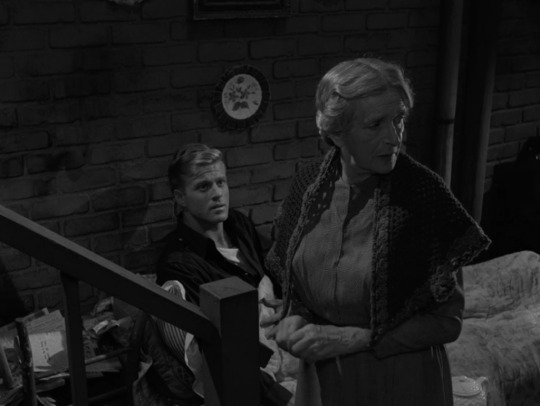
I always marvel at how beautifully executed Twilight Zone episodes are that take place in a single cramped space with a small cast of characters. This one happens to be a meditation on the nature of fear and death in a basement apartment with an old lady and a young man. George Clayton Johnson is one of the first writers outside of Serling to write for the series and Nothing in the Dark proves he was very capable of handling the tone, style, and themes of the series. Gladys Cooper stars in a few episodes, but this is her most tender and heartfelt role. She has great chemistry with Robert Redford, who plays the ailing baby-faced cop.
The Hitch-Hiker
Season 1, Episode 16
Director: Alvin Ganzer | Writer: Rod Serling (story by Lucille Fletcher)
Nan Adams starts continually seeing the same strange man hitchhiking along the roadside as she drives across the country.

The original version of this story was a radio play written by Lucille Fletcher. In the radio broadcasts of the story, Orson Welles plays the lead. It’s worth a listen after viewing the episode both because Welles is an excellent radio actor and because of how much of the mood of the story in light of the gender swap. When Serling bought the story from Fletcher to adapt it, she did not approve of gender-swapping the protagonist. It’s an interesting point to reflect on. Stevens’ Nan is instantly vulnerable as a young woman traveling completely alone; a strange man maybe stalking her is a real and common danger. Her fear is reasonable and it adds to the anxiety of the gradual revelation that the danger may actually be supernatural. With Welles, a man with such an imposing figure (that comes through in his voice) so quickly disquieted by a random man along the side of the road instantly signals to the listener that there may be more going on than meets the eye (or ear). They’re practically telling two different stories.
And When the Sky Was Opened
Season 1, Episode 11
Director: Douglas Heyes | Writer: Rod Serling (story by Richard Matheson)
Three test pilots are hospitalized after a crash landing. One by one they lose their grip on their very existence.

Speculative fiction stories dealing with space travel in the early days of manned space exploration are such a treat. They’re a window into our collective fears about the speed of our move into unexplored territory; physically, theoretically, and philosophically. This episode wastes no time getting deep into the unexplained. Rather than starting with the crash, it’s a few days later and one of the pilots (Charles Aidman) has already disappeared along with any evidence of his existence; except of course for the memories of his colleague (Rod Taylor). And When the Sky Was Opened is also a great example of what my SO refers to as a “Weird, ain’t it?” episode, where you’re presented with a concept and not given any resolution.
It’s a shame Rod Taylor wasn’t in more episodes. He’s clearly tuned into The Twilight Zone’s frequency.
The Last Rites of Jeff Myrtlebank
Season 3, Episode 23
Director: Montgomery Pittman | Writer: Montgomery Pittman
When a young Jeff Myrtlebank wakes up at his own funeral, he’s not quite the same as he used to be.

Confession: when I was a kid, I hated the folksy episodes of The Twilight Zone. I didn’t relate to the oft idealized, fictionalized version of the American Middle West. I can’t say I relate to it exactly, but as I’ve traveled more and met a lot more people from the Midwest, the South, & Appalachia, I can appreciate it better now, albeit from a distance.
The episode begins with an homage to Mark Twain’s The Adventures of Tom Sawyer and then moves into an imagining of what would happen if the devil showed up in St. Petersburg. The musical cues are often a little over the top, but the performances aren’t. All the supporting characters are very realistic* and it makes Jeff (James Best) stick out all the more. Best will go from sprightly to morose to furious in a single scene. He does great work varying his voice, facial expressions, and posture to convey that he’s not quite Jeff and it’s genuinely scary at times.
*(note: not insultingly backwoodsy or prone to superstition as stereotypes might dictate)
Eye of the Beholder
Season 2, Episode 6
Director: Douglas Heyes | Writer: Rod Serling
A woman recovering from extensive plastic surgery is hoping against hope that the procedure will make her “normal-looking” so that she can have a regular life in her repressive society.

Technically, this episode is exquisite. The lighting and cinematography turn the plainness of a hospital into a ghastly limbo. The point of the story might be a bit overwrought, but the monologues are delivered by Maxine Stuart as Janet Tyler are powerful, especially paired with the acting she does with her hands. If you already know the twist of the episode, it’s a whole lot of fun to track how the director and DP work around the reveal.
While Maxine Stuart plays the role of Janet beneath the bandages, Janet is played by Donna Douglas of Beverly Hillbillies fame post recovery. Originally this was rationalized as the director wanting Janet to sound a certain way and look a certain way and it would be easier to cast by voice and looks separately then just dub the actress with the looks. Then, when Douglas showed up to film, she insisted she could sound like Stuart and, lo, she does.
I Sing the Body Electric
Season 3, Episode 35
Director: James Sheldon & William Claxton | Writer: Ray Bradbury
When three children aren’t coping well with the loss of their mother, their father tries out a new robot grandma service.
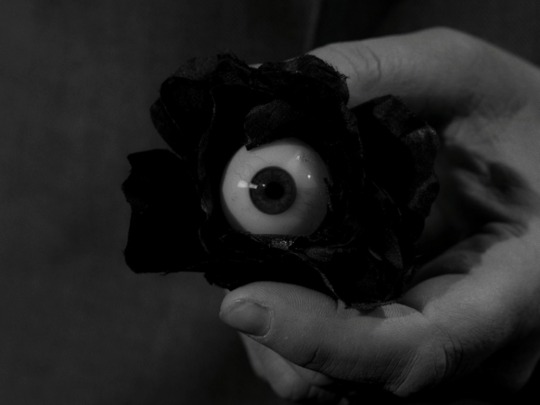
I Sing the Body Electric has a truly unique atmosphere compared to other Twilight Zone episodes. It could be that it’s the only story Ray Bradbury wrote for the show. It could be the edge of artificiality created by the lighting in many of the scenes. Or that the presentation of a loving man-made grandmother emerging from a void is more theatrical than usual. It’s likely a mix of the three, but it’s a strange one no matter. As the grandmother emerges from a void, she retires to a room of grandmother voices. It hints at an amazing AI concept.
Honorable Mention:
The Masks
Season 5, Episode 9
An Occurrence at Owl Creek Bridge
Season 5, Episode 22
The After Hours
Season 1, Episode 34
The Big Tall Wish
Season 1, Episode 27
#The Twilight Zone#Twilight Zone#Rod Serling#Twilight Zone Marathon#new year's#new year's day#new year's eve#Richard Matheson#Ray Bradbury#Montgomery Pittman#agnes moorehead#rod taylor#inger stevens#gladys cooper#robert redford#speculative fiction#science fiction#sci-fi#fantasy#horror#television#tv#list#best of
49 notes
·
View notes
Text
Anthology - 065 - Two (The Twilight Zone S03E01) + Marked ‘Danger’ (Science Fiction Theatre S01E11)
Today I kick off season 3 of Anthology with a review of #TheTwilightZone's 3rd season premiere: "Two" and a bonus review of Science Fiction Theatre's Marked ‘Danger’.
http://traffic.libsyn.com/anthologypod/AP065.mp3 RIGHT CLICK ANTHOLOGY IMAGE, “SAVE LINK AS” TO DOWNLOAD THE EPISODE… This week, I review episode 1 from The Twilight Zone’s third season: Two. I also share my thoughts on episode 11 of Science Fiction Theatre’s first season, Marked ‘Danger’, in a brief spoiler-free bonus review. Continue reading

View On WordPress
0 notes
Photo

“The Twilight Zone”: The Last Rites of Jeff Myrtlebank (Mongomery Pittman, 1962)
#the twilight zone#the last rites of jeff myrtlebank#montgomery pittman#tv#pipe#james best#rod serling#1962
12 notes
·
View notes
Text
fantasy football draft cheat sheet 2022 mod menu 6MY+
💾 ►►► DOWNLOAD FILE 🔥🔥🔥🔥🔥 Fantasy Football Draft Rankings, Consensus Draft Rankings, Overall Cheat Sheets | FantasyPros. RK, Player Name, POS, BYE, SOS. Here's a collection of downloadable, printable cheat sheets for the fantasy football season, including PPR, non-PPR and dynasty/keeper. Fantasy Rankings Top cheat sheet for standard fantasy football drafts ; 10, Ja'Marr Chase, Bengals, WR ; 11, Alvin Kamara, Saints, RB. PFN's fantasy football cheat sheet is here to help you with your tough Week 4 decisions and also to provide you with Underdog Pick'em advice. NFL Fantasy Football Draft cheat sheet for standard scoring format · 1. Justin Jefferson · 2. Cooper Kupp · 3. Ja'Marr Chase · 4. Tyreek Hill. Up to date Fantasy cheat sheet for standard scoring. No need to prepare your Draft, whether you're a beginner or experienced player, just use this list and you'll be set. In Standard Scoring Leagues you don't get points for receptions, so you will have to prioritize touchdown-heavy players. In this format, running backs are going to be a priority, so they have a slight edge over wide receiver. However, a receiving running back is also important because you have double the chance to score. If your league allows it, I would start three RBs every week. These will get you the most touchdowns besides a quarterback. So, remember to do after those red zone threats. In the end, they will make the difference when it comes to Standard Scoring formats. Josh Allen 2. Patrick Mahomes 3. Justin Herbert 4. Joe Burrow 5. Lamar Jackson 6. Jalen Hurts 7. Matthew Stafford 8. Kyler Murray 9. Russell Wilson Dak Prescott Derek Carr Tom Brady Aaron Rodgers Trey Lance Kirk Cousins Tua Tagovailoa Trevor Lawrence Jameis Winston Matt Ryan Ryan Tannehill Deshaun Watson Jared Goff Zach Wilson Daniel Jones Carson Wentz Justin Fields Baker Mayfield Marcus Mariota Mac Jones Mitch Trubisky Jimmy Garoppolo Drew Lock Davis Mills Kenny Pickett Sam Darnold Desmond Ridder Jacoby Brissett Gardner Minshew Teddy Bridgewater Andy Dalton. Jonathan Taylor 2. Najee Harris 3. Joe Mixon 4. Derrick Henry 5. Austin Ekeler 6. Christian McCaffrey 7. Dalvin Cook 8. Javonte Williams 9. Nick Chubb Cam Akers D'Andre Swift Alvin Kamara Aaron Jones Saquon Barkley Josh Jacobs Ezekiel Elliott Elijah Mitchell Breece Hall James Conner Leonard Fournette David Montgomery Damien Harris Dobbins AJ Dillon Miles Sanders Antonio Gibson Devin Singletary Travis Etienne Kareem Hunt James Cook Chase Edmonds Clyde Edwards-Helaire Ken Walker James Robinson Dameon Pierce Melvin Gordon Tony Pollard Raheem Mostert Rhamondre Stevenson Ronald Jones Isaiah Spiller Michael Carter Rashaad Penny Alexander Mattison Jamaal Williams Marlon Mack Chuba Hubbard Cordarrelle Patterson D'Onta Foreman Damien Williams Tyler Allgeier Kenyan Drake McKissic Nyheim Hines Darrell Henderson Tyrion Davis-Price Rachaad White Gus Edwards Khalil Herbert Keaontay Ingram Zamir White Mark Ingram Sony Michel Hassan Haskins Samaje Perine Zack Moss Kenneth Gainwell Pierre Strong Giovani Bernard Duke Johnson Boston Scott Kene Nwangwu Myles Gaskin Benny Snell D'Ernest Johnson Jeff Wilson Kyren Williams Rex Burkhead Ke'Shawn Vaughn Matt Breida Joshua Kelley Eno Benjamin Jaret Patterson Snoop Conner Tevin Coleman Anthony McFarland Ryquell Armstead Craig Reynolds Darrynton Evans Mike Boone Dontrell Hilliard Tony Jones DeeJay Dallas Jermar Jefferson Trey Sermon Chris Evans Jerome Ford Justin Jefferson 2. Cooper Kupp 3. Ja'Marr Chase 4. Tyreek Hill 5. Davante Adams 6. Deebo Samuel 7. Stefon Diggs 8. Terry McLaurin 9. Mike Evans CeeDee Lamb Brown Keenan Allen Michael Pittman Courtland Sutton Mike Williams DK Metcalf DJ Moore Amari Cooper Diontae Johnson Tee Higgins Brandin Cooks JuJu Smith-Schuster Michael Thomas Chris Godwin Allen Robinson Amon-Ra St. Jerry Jeudy Chase Claypool Brandon Aiyuk Gabriel Davis Adam Thielen Mecole Hardman Jaylen Waddle DeAndre Hopkins Kenny Golladay Darnell Mooney DeVonta Smith Treylon Burks Allen Lazard Rashod Bateman Marquise Brown Jarvis Landry Christian Kirk Drake London Tyler Lockett Elijah Moore Michael Gallup Chris Olave Robert Woods Hunter Renfrow Christian Watson DeVante Parker Tyler Boyd Skyy Moore DJ Chark Corey Davis Alec Pierce Marvin Jones Marquez Valdes-Scantling Garrett Wilson Green Terrace Marshall Randall Cobb Jameson Williams Robbie Anderson Jamison Crowder Jakobi Meyers Jahan Dotson David Bell Kadarius Toney Nico Collins Russell Gage Sammy Watkins Van Jefferson Byron Pringle Bryan Edwards Zay Jones Odell Beckham Jr. Parris Campbell Jalen Tolbert Kendrick Bourne Rondale Moore Joshua Palmer Devon Allen Sterling Shepard Donovan Peoples-Jones Julio Jones Curtis Samuel John Metchie George Pickens Marquez Callaway Cedrick Wilson Darius Slayton Nelson Agholor James Washington Romeo Doubs Tyquan Thornton Josh Reynolds Tre'Quan Smith. Travis Kelce 2. Mark Andrews 3. Kyle Pitts 4. George Kittle 5. Darren Waller 6. Zack Ertz 7. Dallas Goedert 8. Dalton Schultz 9. Hunter Henry Hockenson Pat Freiermuth Mike Gesicki Dawson Knox Gerald Everett Albert Okwuegbunam Noah Fant Logan Thomas Cole Kmet Austin Hooper David Njoku Robert Tonyan Tyler Higbee Evan Engram Cameron Brate Mo Alie-Cox Uzomah Jelani Woods Irv Smith Hayden Hurst Adam Trautman Howard Jonnu Smith Harrison Bryant Ricky Seals-Jones Donald Parham Trey McBride Will Dissly Dan Arnold Tommy Tremble Tyler Conklin Brevin Jordan Foster Moreau Blake Bell Isaiah Likely Drew Sample John Bates Greg Dulcich. Justin Tucker 2. Daniel Carlson 3. Matt Gay 4. Harrison Butker 5. Tyler Bass 6. Evan McPherson 7. Younghoe Koo 8. Ryan Succop 9. Matt Prater Brandon McManus Rodrigo Blankenship Jason Sanders Dustin Hopkins Greg Zuerlein Robbie Gould Jake Elliott. Buffalo Bills 2. San Francisco 49ers 3. Indianapolis Colts 4. New England Patriots 5. Tampa Bay Buccaneers 6. Los Angeles Rams 7. Denver Broncos 8. New Orleans Saints 9. Miami Dolphins Kansas City Chiefs Los Angeles Chargers Dallas Cowboys Cleveland Browns Green Bay Packers Pittsburgh Steelers Baltimore Ravens. Fantasy Football.
2 notes
·
View notes
Text
← back to navigation
high activity
stella monroe - 26-31 years old - dianna agron fc - pansexual desires | face | kinks
ivanna marks - 26-31 years old - camila mendes fc - pansexual desires | face | kinks
jason griffin - 35-39 years old - henry cavill fc - heterosexual desires | face | kinks
grant carpenter - 49-53 years old - andrew lincoln fc - heterosexual desires | face | kinks
christian deleon - 33-42 years old - lewis tan fc - heterosexual desires | face | kinks
test muses
frankie benton - 38-46 years old - jessica chastain fc - pansexual desires | face | kinks
rowan dunn - 25-29 years old - grace van dien fc - pansexual desires | face | kinks
arden blackwell - 29-34 years old - jessie mei li fc - pansexual desires | face | kinks
aida warren - 24-29 years old - alycia debnam carey fc - pansexual desires | face | kinks
nicholas vaughn - 34-39 years old - ben barnes fc - heterosexual desires | face | kinks
darren pittman - 28-34 years old - dacre montgomery fc - heterosexual desires | face | kinks
samuel hart - 48-57 years old - frank grillo fc - heterosexual desires | face | kinks hanna burgess - 23-29 years old - madelyn cline fc - pansexual desires | face | kinks vincent jimenez - 44-52 years old - pedro pascal fc - heterosexual desires | face | kinks
low to no activity
andrew rogers - 31-36 years old - sebastian stan fc - heterosexual desires | face | kinks
mayson hayes - 38-42 years old - morena baccarin fc - pansexual desires | face | kinks
marie mcdaniels - 41-47 years old - famke janssen fc - pansexual desires | face | kinks
back to mobile nav
0 notes
Text
Radix Dance Convention, Atlanta, GA: RESULTS
High Scores by Age:
Rookie Solo
1st: MIla Simunic-’Never Enough’
2nd: Brenna Ferrell-’Showstopper’
2nd: Alaina Chadbourne-’Walk The Dinosaur’
Mini Solo
1st: Ellie Melchior-’Function’
2nd: Barrett Robison-’Ping’
3rd: Spencer Parnell-’The Return’
3rd: AnaKate Danner-’Unleashed’
3rd: Paislyn Schroeder-’Vibin’
4th: Kaylee Schwamb-’See Me Now’
4th: Lily Planck-’She’s A Lady’
5th: Georgia Beth Peters-’Come Together’
5th: Ava Grace Merritt-’Love Me’
5th: Anslee LeBlanc-’Take Care Of Yourself’
6th: Bella Smith-’Against The Music’
6th: Clare Gibbons-’Baby I’m A Star’
7th: Xin Lee-’Finding Home’
7th: Avery St John-’Tomorrow’s Song’
8th: Londyn Knox-’Without You’
9th: Lauren Fenton-’Boogie Shoes’
9th: Madelyn Laken-’Surprise’
10th: Penelope Thomas-’Love Shack’
10th: Lila Morath-’Miss Velour’
Junior Solo
1st: Amaya Llewellyn-’Must’
1st: Leila Winker-’Takt’
2nd: Emme James Anderson-’Resume’
3rd: Riley Fiorello-’Crippled Bird’
3rd: Estella Guzman-’No Contamination’
3rd: Ally Reuter-’Stagma’
4th: Mia Doyle-’Designated Harmony’
4th: Brinkley Pittman-’Gravity’
4th: Addison Cullather-’Tangent’
5th: Morgan Belyeu-’Older’
5th: Kalli Ramet-’Rock Me Baby’
5th: Roberta Marcos-’Torn’
6th: Luna Powell-’1977′
6th: Ella Paige Moore-’Breaking Point’
6th: Zella Wentz-’Fearless’
7th: Addison ?-’How Does A Moment Last Forever’
7th: Collier McLain-’Love Has No Limits’
7th: Mia Mondok-’Music Box’
7th: Gabriela Miller-’Sinking’
8th: Mia Narvaez-’Destinations’
8th: Amanda Fenton-’Devil In Disguise’
8th: Annabel Ellis-’The Forest’
8th: Sidney Hill-’The Moon’
9th: Zoe Kappler-’Changeling’
9th: Callie Ludtke-’Impossible’
9th: Leah Midgett-’Mirror Mirror’
10th: Kinley Andrews-’All That Jazz’
10th: Meredith Lee-’Especially A Woman’
Teen Solo
1st: Harlow Ganz-’End of Love’
1st: Preslie Rosamond-’Possibly Maybe’
2nd: Emery Sousley-’Birds of Paradise’
3rd: Olivia Taylor-’Closure’
3rd: Oliver Keane-’Electric Pulse’
4th: Kenzie Robertson-’1977′
4th: Josh Stephens-’Fires’
4th: Johanna Jessen-’Party’
4th: Gabriella Kennedy-’Ritz’
4th: Rianna Weck-’Sensory Overload’
5th: Delaney Lorenz-’Creep’
5th: Haley Midgett-’Smile to Me’
5th: Sydney Tam-’Touch’
6th: Natalie Bumgarner-’Maybe This Time’
6th: Kate Higginbotham-’Polly’
7th: Kennedi Washington-’Epilogue’
7th: Kayla Pierce-’Fire Speak’
7th: Kayla Montgomery-’Lalia’
8th: Cady Cropper-’Godspeed’
8th: Maddie Laine Callaway-’Piece by Piece’
9th: Mia Lott-’Flawless’
9th: Jordan Stevener-’Ghosts’
9th: Ally Organo-’Like You’ll Never See Me Again’
10th: Julia Deana-’Hate You’
10th: Madison marshall-’Icon’
10th: Dempsey Foxson-’Vain’
Senior Solo
1st: Seth Gibson-’Identity’
1st: Dai Boyd-’Try A Little Tenderness’
2nd: Libby Wiley-’By Thy Light’
3rd: Brittany Willard-’Unchained Melody’
4th: Raven Rutledge-’A Pale’
5th: Rebecca Lewyn-’Devil I Know’
5th: Anna Goodman-’Fallen Alien’
5th: Alexandra Jinglov-’Take It Easy’
6th: Belle Mason-’Drones’
6th: Katelynn Midgett-’Georgia’
6th: Ayana Davis-’Progressing’
7th: Kaili Tam-’Malamente’
7th: Elaina Samady-’Loving Ghosts’
7th: Ally Pereira-’Daring to Love’
7th: CJ Parker-’A Letter From France’
7th: Madison Phelps-’A Feeling Felt’
7th: Avery Ferguson-’When You Sleep’
8th: Izzie Bringle-’Hush’
8th: Molly Fisher-’Moved’
8th: Lexi Elias-’The Weight’
9th: Gracie Avalos-’A Body’
9th: Kirsten Brown-’Asylum’
9th: Julia Hale-’Cellophane’
10th: Brooke Manchester-’Go’
10th: Ainsley Wharton-’These hands’
10th: Sophie Hooker-’We’ll Meet Again’
Mini Duo/Trio
1st: Academy for The Performing Arts-’Fall For You’
2nd: Milele Academy-’Miami’
3rd: Studio 413-’Party Planners’
3rd: Milele Academy-’Vibology’
Junior Duo/Trio
1st: Milele Academy-’Fiyah Speak’
1st: Academy for the Performing Arts-’Oceania’
2nd: B-viBe The Dance Movement-’The Mess We’re In’
3rd: Dance Productions Unlimited-’Superpowers’
Teen Duo/Trio
1st: The Royal Dance Academy-’Greiving’
2nd: Milele Academy-’Down We Go’
2nd: Accolades Movement Project-’I Remember Her’
3rd: Studio 413-’Distortion’
3rd: Academy for the Performing Arts-’Fledglings’
3rd: Academy for the Performing Arts-’Rebuild’
3rd: Academy for the Performing Arts-’Tiny Cities’
Senior Duo/Trio
1st: Studio 413-’Black Flies’
2nd: Milele Academy-’Darkest Hour’
3rd: B-viBe The Dance Movement-’Heartbeat’
Rookie Group
1st: Elite Studio-’I Don’t Want to Show Off’
2nd: Elite Studios-’90′s Babies’
Mini Group
1st: Encore Studio-’Uptown Girl’
2nd: Encore Studio-’Windowdipper’
3rd: Encore Studio-’Turn to Stone’
Junior Group
1st: Jill’s Studio of Dance-’All I Want’
1st: B-viBe The Dance Movement-’Down The Line’
1st: B-viBe The Dance Movement-’History In The Making’
2nd: Milele Academy-’Save a Horse’
3rd: Elite Studio-’Collective Breath’
Teen Group
1st: Academy for the Performing Arts-’Don’t Forget Me’
1st: Encore Studio-’Kinjabang’
2nd: Studio 413-’Social Media Overload’
3rd: Milele Academy-’Close Up’
Senior Group
1st: Elite Studios-’I Still Remain’
2nd: Milele Academy-’Get It’
3rd: Academy for the Performing Arts-’Holdin Out’
Rookie Line
1st: Encore Studio-’Conga’
Mini Line
1st: Jill’s Studio of Dance-’Jailhouse Rock’
2nd: Encore Studio-’Truth’
3rd: Elite Studio-’Get Busy’
3rd: Elite Studios-’What You Did To Me’
Junior Line
1st: Milele Academy-’Missy’
2nd: Jill’s Studio of Dance-’It’s About That Walk’
3rd: Studio 413-’Into the Night’
Teen Line
1st: Studio 413-’Hold On Tight’
2nd: Encore Studio-’Yikes’
3rd: Encore Studio-’Just Say’
Senior Line
1st: Studio 413-’Rumors’
2nd: Jill’s Studio of Dance-’Lost’
3rd: Jill’s Studio of Dance-’Who You Are’
Mini Extended Line
1st: Encore Studio-’Vibeology’
2nd: Studio 413-’Critical Level’
3rd: Jill’s Studio of Dance-’I’m Alive’
Junior Extended Line
1st: Jill’s Studio of Dance-’Covergirl’
1st: Jill’s Studio of Dance-’Footloose’
1st: Studio 413-’Goodbye’
2nd: Studio 413-’Girl Boss’
Teen Extended Line
1st: Studio 413-’No One’
2nd: Studio Powers-’BLACK’
3rd: Studio 413-’Ready or Not’
Senior Extended Line
1st: Jill’s Studio of Dance-’Shut It Down’
2nd: Jill’s Studio of Dance-’Trust Me Again’
3rd: Jill’s Studio of Dance-’Resolution’
Junior Production
1st: Studio 413-’Electricity’
Teen Production
1st: Encore Studio-’Cardi’
2nd: Jill’s Studio of Dance-’JLo’
3rd: Elite Studio-’That 70′s Show’
High Scores by Performance Division:
Rookie Jazz
1st: Encore Studio-’Conga’ 2nd: Elite Studio-’I Don’t Want to Show Off’
Rookie Tap
Elite Studios-’90′s Babies’
Mini Jazz
1st: Encore Studio-’Uptown Girl’ 2nd: Jill’s Studio of Dance-’Jailhouse Rock’ 3rd: Milele Academy-’Move Your Body’
Mini Hip-Hop
Studio 413-’Lose Control’
Mini Tap
Studio 413-’Critical Level’
Mini Contemporary
1st: Encore Studio-’Windowdipper’ 2nd: Encore Studio-’Turn to Stone’ 3rd: Encore Studio-’Truth’
Mini Lyrical
1st: Elite Studios-’Every Single Thing I Have’ 2nd: Vermont Ballet Theater-’Build It Up’
Mini Specialty
Jill’s Studio of Dance-’I’m Alive’
Junior Jazz
1st: Jill’s Studio of Dance-’Covergirl’ 2nd: Studio 413-’Electricity’ 3rd: Milele Academy-’Save a Horse’ 3rd: Jill’s Studio of Dance-’It’s About That Walk’
Junior Hip-Hop
1st: Milele Academy-’Missy’ 2nd: Studio 413-’Girl Boss’ 3rd: Academy for the Performing Arts-’New Skool’
Junior Tap
1st: Studio 413-’Into the Night’ 2nd: Academy for the Performing Arts-’You Can Feel It’
Junior Contemporary
1st: Studio 413-’Goodbye’ 2nd: B-viBe The Dance Movement-’Down The Line’ 3rd: Elite Studio-’Collective Breath’
Junior Lyrical
Jill’s Studio of Dance-’All I Want’
Junior Musical Theatre
1st: Academy for the Performing Arts-’Guns and Ships’ 2nd: Vermont Ballet Theater-’We Go Together’
Junior Specialty
1st: Jill’s Studio of Dance-’Footloose’ 2nd: B-viBe The Dance Movement-’History In The Making’
Teen Jazz
1st: Encore Studio-’Just Say’ 2nd: Studio 413-’Body Language’ 3rd: Studio 413-’Social Media Overload’
Teen Hip-Hop
1st: Encore Studio-’Yikes’ 2nd: Studio Powers-’BLACK’ 3rd: Jill’s Studio of Dance-’Fire Emoji’
Teen Tap
1st: Studio 413-’No One’ 2nd: Encore Studio-’Cardi’
Teen Contemporary
1st: Studio 413-’Hold on Tight’ 2nd: Encore Studio-’Kinjabang’ 2nd: Academy for the Performing Arts-’Don’t Forget Me’ 2nd: Encore Studio-’Sadness’ 3rd: Milele Academy-’Hurting You’
Teen Lyrical
Vermont Ballet Theater-’Gravity’
Teen Musical Theatre
1st: Elite Studios-’Take Off With Us’ 1st: Academy for the Performing Arts-’Wait For Me’
Teen Specialty
1st: B-viBe The Dance Movement-’Cage of Bones’ 2nd: Studio Powers-’Area 51′
Senior Jazz
1st: Studio 413-’Rumors’ 2nd: Jill’s Studio of Dance-’Shut It Down’ 3rd: Elite Studios-’Sleep’
Senior Hip-Hop
Academy for the Performing Arts-’Welcome to Our Hood’
Senior Tap
Academy for the Performing Arts-’Holdin’ Out’
Senior Contemporary
1st: Elite Studios-’I Still Remain’ 2nd: Milele Academy-’Get It’ 2nd: Jill’s Studio of Dance-’Lost’ 3rd: Jill’s Studio of Dance-’Who You Are’ 3rd: Jill’s Studio of Dance-’Trust Me Again’
Senior Lyrical
1st: Elite Studios-’Kissing You’ 2nd: B-viBe The Dance Movement-’Came Here For Love’
Senior Specialty
1st: Academy for the Performing Arts-’Still Smiling’ 2nd: B-viBe The Dance Movement-’For This You Were Born’
Best of Radix:
Rookie
Elite Studio-’I Don’t Want to Show Off’
Encore Studio-’Conga’
Mini
Milele Academy-’Move Your Body’
Jill’s Studio of Dance-’Jailhouse Rock’
Encore Studio-’Uptown Girl’
Junior
Elite Studio-’Collective Breath’
Milele Academy-’Missy’
B-viBe The Dance Movement-’History In The Making’
Studio 413-’Goodbye’
Jill’s Studio of Dance-’Covergirl’
Teen
Academy for the Performing Arts-’Don’t Forget Me’
Studio 413-’Hold On Tight’
Studio Powers-’BLACK’
Milele Academy-’Hurting You’
Jill’s Studio of Dance-’Fire Emoji’
Encore Studio-’Yikes’
Senior
Milele Academy-’Get It’
Elite Studios-’I Still Remain’
Studio 413-’Rumors’
Academy for the Performing Arts-’Holdin Out’
Jill’s Studio of Dance-’Lost’
Studio Standout:
Elite Studios-’I Still Remain’
Academy for the Performing Arts-’Holdin Out’
B-viBe The Dance Movement-’History In The Making’
Encore Studio-’Yikes’
Jill’s Studio of Dance-’Lost’
Milele Academy-’Get It’
Studio 413-’Hold On Tight’
8 notes
·
View notes
Text
Black Nationalism, Feminism, and the Moynihan report
Selection from Separate Roads to Feminism: Black, Chicana, and White Feminist Movements in America’s Second Wave, by Benita Roth, 2010.
Black Women and Changes in the Civil Rights Movement The Civil Rights movement of the 1950s and 1960s featured Black women activists in prominent roles (Crawford et al. 1990; Giddings 1984; Gray White 1999; hooks 1981; Joseph and Lewis 1981; McNair Barnett 1993; Payne 1989,1990; Robnett 1997; Standley 1990; Terborg-Penn 1978). Although the most public leaders were men, Black women played significant parts in the movement, both on local and national levels, contributions that were noted within the Black community at the time (see Bender 1969; Thomas 1964). Southern Black women's networks were central to the struggle, since Black women had been active in clubs and other political organizations that agitated on behalf of the race, such as the Montgomery Women's Political Council. Among Black college students, 48 percent of participants in sit-ins and Freedom Rides were women (Prestage 1980); Orum's (1970:72) survey of Black college students' participation in Civil Rights protest found that nearly twice as many women as men in the sample participated in protest (2,047 women versus 1,142 men).
Black women probably participated in the movement in disproportionate numbers (Payne 1990), filling roles that formed the backbone of the movement and exercising leadership "behind the scenes." Women were most often "bridge" leaders (Robnett 1997), using local networks to link new activists to national organizing. Their "invisibility" as leaders within the movement (McNair Barnett 1993) has been exacerbated by the tendency to define leadership as belonging only to those with public-speaking roles. For example, Ella Baker chose a place in the Southern Christian Leadership Conference (SCLC) that was out of the spotlight so as not to threaten male egos; nonetheless, she was a key participant in that organization (at one point its interim executive director) and also helped "midwife" the Student Nonviolent Coordinating Committee (SNCC) into existence. Baker insisted that women's work was at the core of the Civil Rights struggle:
“All the churches depended... on women, not men. Men didn't do the things that had to be done and you had a large number of women who were involved in the bus boycott. They were the people who kept the spirit going.” (Payne 1989:890)
And Ella Baker was not alone. Gloria Richardson, Fannie Lou Hamer, Rosa Parks, Ruby Doris Smith Robinson, Diane Nash, and Jo Ann Robinson form an incomplete list of women who were heroes of the movement, if not as widely visible to the public as someone like Dr. Martin Luther King, Jr. (Brock 1990; Fair Burks 1990; Giddings 1984; Locke 1990).
Much of Black women's energy in the movement was used for stereotypical "female" tasks, but the Civil Rights movement also gave Black women a chance to work alongside men in "nontraditional ways" (Marable 1978; Omolade 1994). Women went to jail (and were beaten there) as they handled bus boycotts, field projects, voter registration drives, and challenges to state and national Democratic party leadership. Cynthia Washington had her own voting rights project in Bolivar County, Mississippi, which she did not consider to be an "exceptional" thing for a woman to be coordinating (Washington 1979:238). Even later Black feminist critiques of sexism within the Civil Rights movement acknowledged that women have been given the opportunity "to do far more significant work than white women in their movement" (Bender 1969, citing Eleanor Holmes Norton). Omolade (1994:124) even argued that "traditional" female work took on new meaning in the "radical context and communal settings" of the movement, enabling women to become not just "wives, mothers, or maids," but also "lovers, friend, and comrades."3
Two intertwined changes in the Civil Rights movement of the mid-1960s affected Black women's roles within the movement. First, the social base of the movement shifted; it became younger and more northern. The southern community base that had fostered women's participation became less important to the Civil Rights movement as the student vanguard changed that movement. Second, an ideological program of advocating middle-class, traditional gender roles as a means of remaking the revolutionary Black family developed as part of Black Liberation ideology. Black women who had been active in social protest organizations were asked to become merely supportive and secondary to men. [...]
The Black Liberation ideology that accompanied the Civil Rights movement's shift to a northern, younger social base was characterized by what Giddings (1984) has called a philosophy of "masculinism." This ideological development proved crucial to the emergence of Black feminism. By the mid-1960s, integrationist approaches in the Civil Rights movement gave way to Black Power strategies and resurgent Black nationalism, forming the two major ideological components of Black Liberation. Black Liberation as an ideology was more suited to working within urban and northern contexts, and more popular with younger African Americans; sympathy for the "Black Power" slogan was greater among the young and those born in the North, whose southern roots were more attenuated (Aberbach and Walker 1971).
There were initially significant differences between Black Power and Black nationalism, but by the end of the decade, the two were difficult to distinguish from each other. SNCC was instrumental in the development of Black Power ideology; Stokely Carmichael and Charles Hamilton--authors of Black Power: The Politics of Liberation in America--were SNCC leaders when they began to formulate their ideas in 1966 and when their book was published in 1967 (Matusow 1971). Black Power political philosophy held that African Americans should strive for self-sufficiency and economic progress. Carmichael and Hamilton, holding up ethnic immigrant groups as models, argued that Black people needed to question the benefits of mere formal equality; to become economically empowered, they needed to turn inward, toward strengthening Black communities. Building on older nationalist ideas of self-sufficiency within the Black community, they expressed frustration at the limits of the Civil Rights agenda.
Carmichael and Hamilton were silent about Black women helping the community to gain economic empowerment. Virtually the only mention they make of women's roles was that of
“another set of leaders in the Black community in Lowndes County. This was a group of middle-aged ladies, who knew the community well and were well known. They were to play a very important role in the political organization of the Blacks. They had considerable influence in the Black community--being staunch church members, for example--but they possessed no power at all with the white community.” (Carmichael and Hamilton 1967:102-103)
In contrast to Black Power's silence about Black women, Black nationalism in the mid-1960s was strongly characterized by masculinist discourse and practice.4 According to the nationalists, the truly "revolutionary" Black woman was a supportive one, who kept house while the Black man kept revolution, so as to allow him to reclaim his public manhood (Marable 1983). Despite the work of Black women in the Civil Rights movements, and the very public presence of a small number of women in Black nationalist organizations themselves (e.g., Angela Davis, Kathleen Cleaver, and Elaine Brown), Black nationalist organizations such as Maulana Ron Karenga's US movement and the Black Muslims advocated restricting opportunities for activism by women (Brown 1992). In this traditionalist take on women's roles, the Black nationalist resurgence of the 1960s differed from the older formulations. Whatever tensions existed between Black men and women in activist groups (see Gray White 1999), older Black nationalism did not seem to require as rigid an ideology of traditional sex roles, as was evidenced by Amy Garvey's strong advocacy of women's equality and the key role she played in the 1920s Garveyist movement (Adler 1992; Gray White 1999; White 1984).5
During the 1960s, masculinism was very much present in other parts of the Left and in other parts of the Black community; for example, the traditional gender role ideology of the much-admired Black Muslims added legitimacy to masculinist ideas about delimiting women's roles in the movement (Kashif 1970). However, Black feminists (both then and now) have argued that the masculinist cast of Black nationalism in the 1960s was a reaction to the "Black matriarchy" theory in the 1965 Moynihan report, The Negro Family: The Case for National Action (Dubey 1994; Giddings 1984; Gray White 1999; hooks 1981; Murray 1975; see Pittman quoted in Cantwell 1971; Wallace 1996). The resurgent masculinism of Black Liberation was therefore tied to state intervention into the relationships that existed within the Black family; Black feminism in part responded to the aftereffects of this intervention. In reaction to the Moynihan report, Black masculinists attempted to counter the depiction of Black men as the most abject victims of racial discrimination, with Black women putatively better off by virtue of participation in the labor force. The report concluded that the Black family was "matriarchal" and "deviant," because women held an inappropriately large amount of power (this despite the fact that Black women's status as the most economically deprived group in the country was also noted). This "deviant" family structure hindered the progress of Black men, and, by extension, that of the Black community itself (Dubey 1994; see also Marx Ferree and Hess 2000).
Black nationalists condemned the report as racist, but many responded that the patriarchal family had to be reinstituted so as to right the historical wrongs done to the Black male. With this analysis in place, Black nationalist organizations "prescribed clearly restricted roles for black women in the movement" (Dubey 1994:18). The behind-the-scenes roles that women played in the Civil Rights movement were no longer far enough behind the scenes; women were to be supportive and subordinate, producing "male warriors for the revolution" within newly patriarchal families (Dubey 1994:18). Existing Black family structures, which were based on extended kinship networks, and where illegitimacy carried less stigma than in middle-class white society, were to be changed in favor of the nationalist model of a nuclear patriarchal family. This stance on the need to return to "traditional"--even if largely fictional--gender roles in the Black community was also accompanied by calls for Black women to end their use of birth control. At the Black Power conference held in Newark in 1967, organized by Amiri Baraka, an anti-birth control resolution was passed (Ross 1993); the possibility of Black women helping to carry out Black genocide by using birth control would continue to be a hotly contested issue between Black nationalists and emerging Black feminists, as will be discussed later.
In general, then, the Moynihan report was seized upon by many Black male activists as both a manifestation of white racism and proof that Black women out of their traditional place were abetting that racism. As Gray White (1999:200) argued, the report "legitimized the perception of black women as unnaturally strong and emasculating." But the masculinist reaction to Moynihan also found itself challenged by Black feminist organizing, as some Black women activists, facing problems in their ongoing struggles as activists, responded by uncovering the contradictions that confronted them.
Black Feminists Respond: Early Organizations By 1968, Black feminists had responded publicly to the Black Liberationist/nationalist emphasis on traditional gender roles. Their critiques were nuanced ones, directed as much at white society as at the changes in the Black movement. They condemned advocacy of a patriarchal family structure by Black Liberationists even as they attacked the racism they found in Moynihan's depiction of the Black family. Additionally, Black feminists were staunchly anticapitalist, attributing the shortcomings of existing movements to a failure to carry through on the full implications of revolutionary politics. [...]
The Black Woman, Black Liberation, and Middle-Class Style The members of TWWA [Third World Women’s Alliance] and the Mount Vernon Group were not entirely on their own; Toni Cade (Bambara) (1970a:107) wrote that in the late 1960s, it seemed "that every organization you can name has had to struggle at one time or another with seemingly mutinous cadres of women getting salty about having to man the telephones or fix the coffee while the men wrote the position papers and decided on policy." By 1970, the voices of the "mutinous cadres" of women described by Cade (Bambara) were gathered into her watershed edited collection entitled The Black Woman. Conceived as a dialogue with the Black movement--but unable to avoid some dialogue with white women's liberation--the book was organized out of her "impatience" with the lack of real information about the lives and politics of Black women (1970b: 10). The contributors to the collection were primarily writers and activists who spoke as members of older women's groups, Black liberation groups, Civil Rights groups, New Left groups, and no groups at all.
As might be expected, many of the pieces in The Black Woman were characterized by concerns over Black Liberationist/ nationalist reactions to the Moynihan report, and the specific failure of those reactions to maintain revolutionary consistency regarding gender roles. As noted, [Frances] Beal's "Double Jeopardy" appeared in the collection; one of the Mount Vernon Group's position papers appeared, entitled "On the Position of Poor Black Women in this Country" (which, like "Statement on Birth Control," was widely reprinted and distributed throughout the white women's liberation movement). In this piece, [Patricia] Robinson and her group continued criticism of middle-class Black leaders as a self-interested elite leading poor Blacks down the garden path of capitalism, linking class, gender, and racial oppression as belonging to one grand package:
“Capitalism is a male supremacist society.... All domestic and international political and economic decisions are made by men and enforced by males.... Women have become the largest oppressed group in a dominant, male, aggressive, capitalistic culture.... Rebellion by poor black women, the bottom of a class hierarchy... places the question of what kind of society will the poor black woman demand.... Already she demands the right to have birth control, like middle class black and white women.... She allies herself with the have-nots in the wider world and their revolutionary struggles.... Through these steps ... she has begun to question aggressive male domination and the class society which enforces it, capitalism.” (Robinson et al. 1970a:196)
Robinson and the group argued for a united front of middle-class Black and white women who would join poor Black women in continuing to expose male oppression. At the "bottom of a class hierarchy," poor Black women in concert with others would be able to lead this united front toward liberation for all exploited people (1970a: 196).
The anticapitalist critique of American society and the Black Liberation movement was present in other contributors' work in The Black Woman. In her essay, Gwen Patton (1970) also argued that capitalism was at the root of what she called the "Victorian Philosophy of Womanhood." According to Pam Allen, herself an activist in the Civil Rights and white women's liberation movement, Patton sent Bob Allen (Pam Allen's husband) a draft of her piece for the collection in August of 1968; Pam Allen thought it should be published because "it would be the first time we (or perhaps any paper) have printed a black woman's objection to women assuming supportive roles to black men" (Allen 1968b). Arguing that Black male militants should be more savvy about the intent and impact of the Moynihan report, Patton chastised Black male activists for not seeing through the report:
“Black men... responded] positively toward Black Power and could assert their leadership, which included a strengthening of their masculinity Black women will now take the back position [A] victory for the capitalistic system! Black men are now involved with keeping their women in line by oppressing them more, which means that Black men do not have time to think about their own oppression. The camp of potential revolutionaries has been divided.” (1970:146-147)
Patton recommended that Black women challenge Black men directly, so that the Victorian philosophy "of men on top, women on bottom" (1970:147-148) could be destroyed and the road could be cleared for real revolution.
Besides Patton, other contributors to The Black Woman wrestled directly with the Moynihan report, with the Black Liberationist "manhood" preoccupation that was restricting Black women's activism, and with the effects of capitalism on the Black community (Cade [Bambara] 1970a; Carey Bond and Perry 1970; Lincoln 1970; Lindsey 1970). Kay Lindsey's essay in The Black Woman echoed the idea that Black militants had been seduced by capitalist promises, and that the "Black middle class" were "pseudo-escapees into the mainstream" who had assumed "many of the institutional postures of the oppressor, including the so-called intact family" (1970:86). Lindsey argued that white establishment efforts to "encourage the acquisition of property among Blacks via Black Capitalism... would probably serve to further intensify the stranglehold on women as property" (1970:86-87).
And contributors also had concerns about Black Liberation's anti-birth control stance, following the stance first articulated by the Mount Vernon Group. Black Liberationist anti-birth control politics did not stop at rhetoric; in 1969, Black nationalists from the United Movement for Progress closed down a birth control clinic in Pittsburgh, which was subsequently reopened by community women (Lindsey 1970). Cade (Bambara) (1970c: 163-164) wrote of attending a workshop given by a Black Liberation group that degenerated into a diatribe against birth control. She described how "one tall, lean dude... castigated the Sisters to throw away the pill and hop to the mattresses and breed revolutionaries and mess up the man's genocidal program." One of the women present responded with a question about the "dude's" financial responsibility in this: "[W]hen's the last time you fed one of them brats you been breeding all over the city, you jive-ass so-and-so?"
The writings contained in The Black Woman represented a polyphonous response to the traditional gender ideology that Black Liberationists were espousing as revolutionary; in other places, Black feminists were agreeing that Black Liberation's sexism was rooted in their unquestioning adoption of middle-class values alien to the Black community. On the West Coast, in Seattle, Nina Harding, then a thirty-one-year-old Black Studies major at the University of Washington, a mother, and an employee of the Seattle Opportunities Industrialization Center, wrote a position paper entitled "The Interconnections Between the Black Struggle and the Woman Question," which she presented at the annual conference of the Seattle Radical Women in February 1970. In it, Harding also argued that Black Liberation, otherwise critical of capitalism, had accepted traditional ideas about women's roles, and she blamed these retrograde attitudes on unquestioning acceptance of the Muslims; but she was also critical of Black "bourgeois sisters and silent sisters," who hold to "WASP standards, be those standards interpreted by the Muslim or Nationalist advocates" (1970:4). Other Black feminists in other cities echoed the idea that Black Liberation was importing white middle-class values into the heart of the Black community (Holmes Norton 1970). When interviewed by a Los Angeles Times reporter in June of 1970, Margaret Wright, a member of the Los Angeles Black women's liberation group, declared it impossible for Black families to be shaped like white ones because of class domination:
“[T]he black man is saying he wants a family structure like the white man's. He's got to be head of the family and women have to be submissive and all that nonsense. Hell the white woman is already oppressed in that setup.” (1972:608)
On both coasts, then, Black feminists rejected attempts by Black Liberationists to use middle-class gender ideology to bolster Black male "manhood."
#feminism#feminist history#black feminism#black women#women of color#united states#us history#moynihan#moynihan report#separate roads to feminism#benita roth#gender#patriarchy#capitalism#racism
16 notes
·
View notes
Text
SETTLERS - Review
DISTRIBUTOR: IFC Midnight

SYNOPSIS: On a remote homestead amongst the Martian frontier, a refugee family from Earth clings to hope for a better life. But when strangers appear in the surrounding hills and attempt to run them off, nine-year-old Remmy is faced with the desperate reality her mother and father have tried so hard to keep from her.
REVIEW: SETTLERS is a hybrid of a science fiction movie with classic western plot devices. There are very few original films that did it well, and only “Outland (‘’81),��� “Prospect (‘18)” and “Silent Running (‘72)” realized their goals in blending both genres successfully. For all the tech and hardware, a good science fiction film allows the viewer to examine the human condition in a new light. SETTLERS is one of those films.
Wyatt Rockefeller’s screenplay is a complex character driven narrative. He does an excellent job of introducing each one and slowly peels back their layers so we come to know them, understand them. They are an unlikely group who are brought together for a simple reason, but the frightening larger consequences he hints at, leaving our imagination to dwell on it. At the core of the story is Remmy, a child who has never known earth and is raised on stories about the home planet of her parents. Even though she has been raised in this harsh environment she still has a child’s sense of curiosity and wonder. The adults in the tale are presented as desperate survivors. However, the character of Jerry holds the knowledge and expertise to possibly this lost homestead. This small island of hope is housed under a dome that keeps it secluded from the rest of the planet. Given the heaviness of the story, Rockefeller injects a bit of comic relief with the inclusion of a simple robot that is capable of presenting a limited, but effective, range of emotions.
As the viewer watches this tragedy unfold you can’t help but feel the connection to several issues we are facing today. They run the gambit of social, political, and environmental. Much like a child, Rockefeller never tips his hand to give us any explanation as to why some of the adults do what they do. What he does offer only feels like it is scratching the surface. There are many elephants in this story. The filmmaker offers the viewer little emotional release. Even the film’s ending is optimistic, but given things we’ve heard in the story it is certainly not hopeful. There are elements of the story that feel reminiscent of the 1961 “The Twilight Zone” episode “Two,” which was written and directed by Montgomery Pittman, starring Charles Bronson and Elizabeth Montgomery. For it being his first feature film, Rockefeller shows he has the talent to have worked alongside any of the writers of that classic series.
Rockefeller and his collaborators did an excellent job of creating the indoor and outdoor environments, and the rest of the area under this dome. You believe they are on mars. Granted they are in a desert, but there were no signs of any other life, except for the plants, in this landscape. I enjoyed the camera work and the editing, especially when it came to taking the viewer from a distant point and slowly brought us into the scene. The location and set dressing looked authentic to a you think an intergalactic settlement might look. They did an amazing job of setting the stage and creating the atmosphere, which they sustain throughout, so the viewer maintains their engagement in the drama.
I loved the performances. Young actress Brooklynn Prince has moments where she is delightful and powerful as she goes through this emotional character arch. All through her struggles she maintains an element of innocence that feels so organic. Actor Ismael Cruz Córdova is a powerhouse of emotions and intensity. You feel that he has a modicum of happiness in moments but there is this lingering tension and anxiety brewing just below the surface. You feel his sincerity of trying to make something good from the situation he is in. Sofia Boutella delivers this heart wrenching performance of a mother being torn apart by these conflicting emotions, rendering many of the character’s actions surprising, shocking, but never something we feel is outside the character’s motivations.
Subtly adding to the film’s complex emotional palette and the atmosphere is a great score by Nitin Sawhney. It is not a constant score throughout, but is nicely woven into the film.
Wyatt Rockefeller’s feature film debut SETTLERS is an impressive orchestration of story, visuals and performances. It is a compelling story that nicely blends the science fiction elements with the tragedy to create a timeless character study of survival in a harsh environment. With Mars looming as the potential new frontier, regardless of all our technical advances Rockefeller’s film presents a cautionary tale of what could happen if we fail to update the human condition before we venture forth. I am totally excited to she what he does with his next film.
CAST: Sofia Boutella, Ismael Cruz Córdova, Brooklynn Prince, Nell Tiger Free, and Jonny Lee Miller CREW: Director/Screenplay - Wyatt Rockefeller; Producers - Julie Fabrizio, Joshua Horsfield & Johan Kruger; Cinematographer - Willie Nel; Score - Nitin Sawhney; Editor - Johnny Daukes; ; Production Designer - Noam Piper; Costume Designer - Dihantus Engelbrecht; Robot & Special Effects - Millennium FX; Visual Effects - Mark Myburgh. OFFICIAL: N.A. FACEBOOK: N.A. TWITTER: N.A. TRAILER: https://youtu.be/jeCcJCy0HzM RELEASE DATE: IN Theaters and On Demand Friday, July 23rd, 2021
**Until we can all head back into the theaters our “COVID Reel Value” will be similar to how you rate a film on digital platforms - 👍 (Like), 👌 (It’s just okay), or 👎 (Dislike)
Reviewed by Joseph B Mauceri
#film review#movie review#settlers#settlersmovie#ifcmidnight#wyatt rockefeller#sofia boutella#ismael cruz córdova#brooklynn prince#science fiction#sci-fi#thriller#joseph mauceri#joseph b mauceri
1 note
·
View note